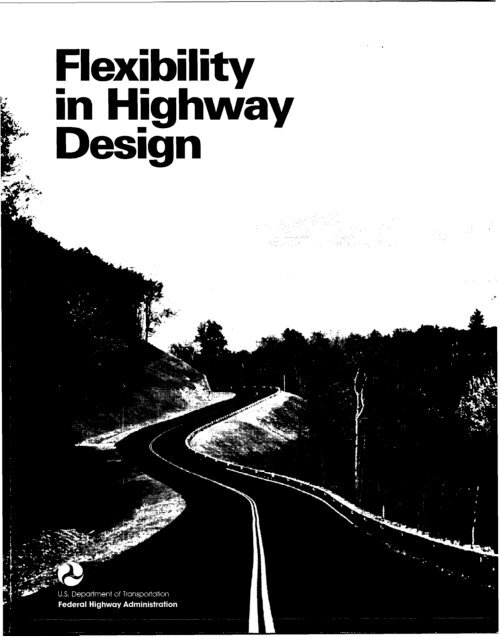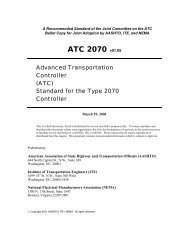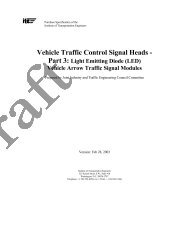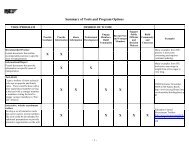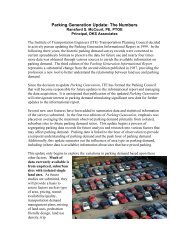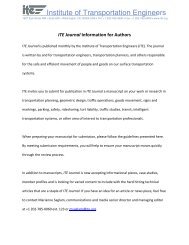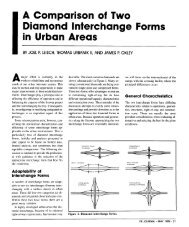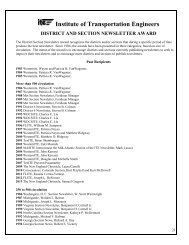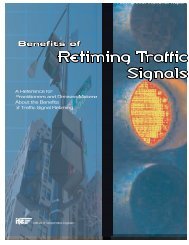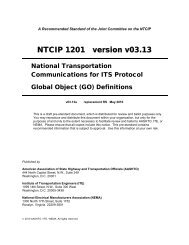Flexibility in Highway Design - Institute of Transportation Engineers
Flexibility in Highway Design - Institute of Transportation Engineers
Flexibility in Highway Design - Institute of Transportation Engineers
You also want an ePaper? Increase the reach of your titles
YUMPU automatically turns print PDFs into web optimized ePapers that Google loves.
<strong>Flexibility</strong><br />
<strong>in</strong> <strong>Highway</strong><br />
<strong>Design</strong>
<strong>Flexibility</strong><br />
<strong>in</strong> <strong>Highway</strong><br />
<strong>Design</strong><br />
U.S. Department <strong>of</strong> <strong>Transportation</strong><br />
Federal <strong>Highway</strong> Adm<strong>in</strong>istration<br />
Page i
A Message from the Adm<strong>in</strong>istrator<br />
Dear Colleague:<br />
One <strong>of</strong> the greatest challenges the highway community faces is provid<strong>in</strong>g safe, efficient<br />
transportation service that conserves, and even enhances the environmental,<br />
scenic, historic, and community resources that are so vital to our way <strong>of</strong> life. This<br />
guide will help you meet that challenge.<br />
The Federal <strong>Highway</strong> Adm<strong>in</strong>istration (FHWA) has been pleased to work with the<br />
American Association <strong>of</strong> State <strong>Highway</strong> and <strong>Transportation</strong> Officials and other<br />
<strong>in</strong>terested groups, <strong>in</strong>clud<strong>in</strong>g the Bicycle Federation <strong>of</strong> America, the National Trust<br />
for Historic Preservation, and Scenic America, to develop this publication. It identifies<br />
and expla<strong>in</strong>s the opportunities, flexibilities, and constra<strong>in</strong>ts fac<strong>in</strong>g designers<br />
and design teams responsible for the development <strong>of</strong> transportation facilities.<br />
This guide does not attempt to create new standards. Rather, the guide builds on<br />
the flexibility <strong>in</strong> current laws and regulations to explore opportunities to use<br />
flexible design as a tool to help susta<strong>in</strong> important community <strong>in</strong>terests without<br />
compromis<strong>in</strong>g safety. To do so, this guide stresses the need to identify and discuss<br />
those flexibilities and to cont<strong>in</strong>ue break<strong>in</strong>g down barriers that sometimes make it<br />
difficult for highway designers to be aware <strong>of</strong> local concerns <strong>of</strong> <strong>in</strong>terested organizations<br />
and citizens.<br />
The partnership formed to develop this guidance grew out <strong>of</strong> the design-related<br />
provisions <strong>of</strong> the Intermodal Surface <strong>Transportation</strong> Efficiency Act <strong>of</strong> 1991 and the<br />
National <strong>Highway</strong> System <strong>Design</strong>ation Act <strong>of</strong> 1995. Congress provided dramatic<br />
new flexibilities <strong>in</strong> fund<strong>in</strong>g, stressed the importance <strong>of</strong> preserv<strong>in</strong>g historic and<br />
scenic values, and provided for enhanc<strong>in</strong>g communities through transportation<br />
improvements. Additionally, Congress provided that for Federal-aid projects not<br />
on the National <strong>Highway</strong> System, the States have the flexibility to develop and<br />
apply criteria they deem appropriate.<br />
It is important, therefore, that we work with our State and local transportation<br />
colleagues to share ideas for proactive, community-oriented designs for transportation<br />
facilities. In this guide, we encourage designers to become partners with<br />
transportation specialists, landscape architects, environmental specialists, and<br />
others who can br<strong>in</strong>g their unique expertise to the important task <strong>of</strong> improv<strong>in</strong>g<br />
transportation decisionmak<strong>in</strong>g and preserv<strong>in</strong>g the character <strong>of</strong> this Nation’s<br />
communities. As illustrated <strong>in</strong> the guidance, we can encourage creativity, while<br />
achiev<strong>in</strong>g safety and efficiency, through the early identification <strong>of</strong> critical project<br />
issues, and through consideration <strong>of</strong> community concerns before major decisions<br />
severely limit design options.<br />
We believe that design can and must play a major role <strong>in</strong> enhanc<strong>in</strong>g the quality <strong>of</strong><br />
our journeys and <strong>of</strong> the communities traveled. This guide will help you achieve<br />
those dual purposes.<br />
S<strong>in</strong>cerely yours,<br />
&*<br />
Jane F. Garvey<br />
Act<strong>in</strong>g Federal <strong>Highway</strong> Adm<strong>in</strong>istrator<br />
Page iii
foreword<br />
FOREWORD<br />
This Guide is about design<strong>in</strong>g highways that <strong>in</strong>corporate community values and<br />
are safe, efficient, effective mechanisms for the movement <strong>of</strong> people and goods.<br />
It is written for highway eng<strong>in</strong>eers and project managers who want to learn more<br />
about the flexibility available to them when design<strong>in</strong>g roads and illustrates<br />
successful approaches used <strong>in</strong> other highway projects. It can also be used by<br />
citizens who want to ga<strong>in</strong> a better understand<strong>in</strong>g <strong>of</strong> the highway design process.<br />
Congress, <strong>in</strong> the Intermodal Surface <strong>Transportation</strong> Efficiency Act (ISTEA) <strong>of</strong><br />
1991 and the National <strong>Highway</strong> System <strong>Design</strong>ation (NHS) Act <strong>of</strong> 1995, ma<strong>in</strong>ta<strong>in</strong>ed<br />
a strong national commitment to safety and mobility. Congress also made<br />
a commitment to preserv<strong>in</strong>g and protect<strong>in</strong>g the environmental and cultural values<br />
affected by transportation facilities. The challenge to the highway design community<br />
is to f<strong>in</strong>d design solutions, as well as operational options, that result <strong>in</strong> full<br />
consideration <strong>of</strong> these sometimes conflict<strong>in</strong>g objectives.<br />
To help meet that challenge, this Guide has been prepared for the purpose <strong>of</strong><br />
provok<strong>in</strong>g <strong>in</strong>novative th<strong>in</strong>k<strong>in</strong>g for fully consider<strong>in</strong>g the scenic, historic, aesthetic,<br />
and other cultural values, along with the safety and mobility needs, <strong>of</strong> our<br />
highway transportation system. This Guide does not establish any new or<br />
different geometric design standards or criteria for highways and streets <strong>in</strong><br />
scenic, historic, or otherwise environmentally or culturally sensitive areas, nor<br />
does it imply that safety and mobility are less important design considerations.<br />
When Congress passed ISTEA <strong>in</strong> 1991, <strong>in</strong> addition to safety, it emphasized the<br />
importance <strong>of</strong> good design that is sensitive to its surround<strong>in</strong>g environment, especially<br />
<strong>in</strong> historic and scenic areas. Section 1016(a) <strong>of</strong> ISTEA states:<br />
If a proposed project...<strong>in</strong>volves a historic facility or is<br />
located <strong>in</strong> an area <strong>of</strong> historic or scenic value, the Secretary<br />
may approve such project...if such project is designed to standards<br />
that allow for the preservation <strong>of</strong> such historic or<br />
scenic value and such project is designed with mitigation<br />
measures to allow preservation <strong>of</strong> such value and ensure<br />
safe use <strong>of</strong> the facility.<br />
Aesthetic, scenic, historic, and cultural resources and the physical characteristics<br />
<strong>of</strong> an area are always important factors because they help give a community its<br />
identity and sense <strong>of</strong> place and are a source <strong>of</strong> local pride.<br />
Page w
In 1995, Congress reemphasized and strengthened this direction through the<br />
NHS Act, which states, <strong>in</strong> section 304:<br />
Foreword<br />
A design for new construction, reconstruction, resurfac<strong>in</strong>g...<br />
restoration, or rehabilitation <strong>of</strong> a highway on the National<br />
<strong>Highway</strong> System (other than a highway also on the Interstate<br />
System) may take <strong>in</strong>to account...[<strong>in</strong> addition to safety, durability<br />
and economy <strong>of</strong> ma<strong>in</strong>tenance]...<br />
(A) the constructed and natural environment <strong>of</strong> the area:<br />
(B) the environmental, scenic, aesthetic, historic, community,<br />
and preservation impacts <strong>of</strong> the activity: and<br />
(C) access for other modes <strong>of</strong> transportation.<br />
The National <strong>Highway</strong> System (NHS) consists <strong>of</strong> approximately 161,000 miles<br />
<strong>of</strong> roads, <strong>in</strong>clud<strong>in</strong>g the Interstate System, or 4 percent <strong>of</strong> the total highway<br />
mileage. The primary purpose <strong>of</strong> the NHS is to ensure safe mobility and access.<br />
By emphasiz<strong>in</strong>g the importance <strong>of</strong> good design for these roads, Congress is say<strong>in</strong>g<br />
that careful, context-sensitive design is a factor that should not be overlooked for<br />
any road.<br />
A Policy on the Geometric <strong>Design</strong> <strong>of</strong> <strong>Highway</strong>s and Streets (Green Book),<br />
published by the American Association <strong>of</strong> State <strong>Highway</strong> and <strong>Transportation</strong><br />
Officials (AASHTO), conta<strong>in</strong>s the basic geometric design criteria that establish<br />
the physical features <strong>of</strong> a roadway. This Guide is correlated to a large extent to<br />
the Green Book because that is the primary geometric design tool used by the<br />
highway design community. Like the Green Book, this Guide conta<strong>in</strong>s sections<br />
on functional classification, design controls, horizontal and vertical al<strong>in</strong>ement,<br />
cross-section elements, bridges, and <strong>in</strong>tersections. There are many good projects<br />
highlighted <strong>in</strong> this Guide that were achieved work<strong>in</strong>g with<strong>in</strong> the parameters <strong>of</strong><br />
the Green Book to obta<strong>in</strong> safety and mobility and to preserve environmental and<br />
cultural resources. These projects used the flexibilities that are available with<strong>in</strong><br />
the criteria <strong>of</strong> the Green Book. These projects also used a comprehensive design<br />
process, <strong>in</strong>volv<strong>in</strong>g the public and <strong>in</strong>corporat<strong>in</strong>g a multidiscipl<strong>in</strong>ary design<br />
approach early and throughout the process.<br />
If highway designers are not aware <strong>of</strong> opportunities to use their creative abilities,<br />
the standard or conservative use <strong>of</strong> the Green Book criteria and related State<br />
standards, along with a lack <strong>of</strong> full consideration <strong>of</strong> community values, can cause<br />
a road to be out <strong>of</strong> context with its surround<strong>in</strong>gs. It may also preclude designers<br />
from avoid<strong>in</strong>g impacts on important natural and human resources.<br />
Page vi
Fore word<br />
This Guide encourages highway designers to expand their consideration <strong>in</strong><br />
apply<strong>in</strong>g the Green Book criteria. It shows that hav<strong>in</strong>g a process that is open,<br />
<strong>in</strong>cludes public <strong>in</strong>volvement, and fosters creative th<strong>in</strong>k<strong>in</strong>g is an essential part <strong>of</strong><br />
achiev<strong>in</strong>g good design. This Guide should be viewed as a useful tool to help<br />
highway designers, environmentalists, and the public move further along the<br />
path to sensitively designed highways and streets by identify<strong>in</strong>g some possible<br />
approaches that fully consider aesthetic, historic, and scenic values, along with<br />
safety and mobility. It also recognizes that many designers have been sensitive to<br />
the protection <strong>of</strong> natural and human-made resources prior to ISTEA.<br />
The decision to use and apply the concepts illustrated and discussed <strong>in</strong> the Guide<br />
for any specific project rema<strong>in</strong>s solely with the appropriate State and/or local<br />
highway agencies. In addition, while many <strong>of</strong> the concepts discussed will clearly<br />
aid the decision process, it must be recognized that changes <strong>in</strong> the design or design<br />
criteria will not always resolve every issue to a mutual level <strong>of</strong> satisfaction.<br />
Page vii
Table <strong>of</strong> Contents<br />
TABLE<br />
OF CONTENTS<br />
Letter from the Adm<strong>in</strong>istrator. .................................. iii<br />
Foreword .................................................<br />
..v<br />
Introduction.. ............................................ ..x i<br />
PART I-THE DESIGN PROCESS<br />
Chapter l-Overview <strong>of</strong> the <strong>Highway</strong> Plann<strong>in</strong>g and Development Process. . . 1<br />
PART II-DESIGN GUIDELINES<br />
Chapter 2-<strong>Highway</strong> <strong>Design</strong> Standards. ........................... 27<br />
Chapter 3-Functional Classification ............................. 41<br />
Chapter 4-<strong>Design</strong> Controls. ................................... 55<br />
Chapter %-Horizontal and Vertical Al<strong>in</strong>ement ...................... 63<br />
Chapter 6-Cross-Section Elements .............................. 73<br />
Chapter 7-Bridges and Other Major Structures. ................... 101<br />
Chapter 8-Intersections ..................................... 113<br />
PART III-CASE STUDIES<br />
l-Route 9 Reconstruction: New York, NY. ....................... 131<br />
2-Carson Street Reconstruction: Torrance, CA .................... 143<br />
3-Historic Columbia River <strong>Highway</strong>:<br />
Multnomah, Hood River, and Wasco Counties, OR ............... 1.51<br />
4-State Route 89 - Emerald Bay: Eldorado County, CA .............. 167<br />
&East Ma<strong>in</strong> Street Reconstruction: Westm<strong>in</strong>ster, MD ............... 175<br />
6-U.S. Route 101 - L<strong>in</strong>coln Beach Parkway: L<strong>in</strong>coln County, OR. ...... 183<br />
Page ix
Introduction<br />
INTRODUCTION<br />
An important concept <strong>in</strong> highway design is that every project is unique. The sett<strong>in</strong>g<br />
and character <strong>of</strong> the area, the values <strong>of</strong> the community, the needs <strong>of</strong> the highway<br />
users, and the challenges and opportunities are unique factors that designers must<br />
consider with each highway project. Whether the design to be developed is for a<br />
modest safety improvement or 10 miles <strong>of</strong> new-location rural freeway, there are<br />
no patented solutions. For each potential project, designers are faced with the task<br />
<strong>of</strong> balanc<strong>in</strong>g the need for the highway improvement with the need to safely <strong>in</strong>tegrate<br />
the design <strong>in</strong>to the surround<strong>in</strong>g natural and human environments.<br />
In order to do this, designers need flexibility. There are a number <strong>of</strong> options<br />
available to State and local highway agency <strong>of</strong>ficials to aid <strong>in</strong> achiev<strong>in</strong>g a balanced<br />
road design and to resolve design issues. These <strong>in</strong>clude the follow<strong>in</strong>g:<br />
l Use the flexibility with<strong>in</strong> the standards adopted for each State.<br />
l<br />
Recognize that design exceptions may be optional where environmental<br />
consequences are great.<br />
l<br />
Be prepared to reevaluate decisions made <strong>in</strong> the plann<strong>in</strong>g phase.<br />
l<br />
Lower the design speed when appropriate.<br />
l<br />
Ma<strong>in</strong>ta<strong>in</strong> the road’s exist<strong>in</strong>g horizontal and vertical geometry<br />
and cross section and undertake only resurfac<strong>in</strong>g, restoration,<br />
and rehabilitation (3R) improvements.<br />
l<br />
Consider develop<strong>in</strong>g alternative standards for each State, especially<br />
for scenic roads.<br />
l<br />
Recognize the safety and operational impact <strong>of</strong> various design<br />
features and modifications.<br />
Page xi
This Guide illustrates the flexibility already available to designers with<strong>in</strong><br />
adopted State standards. These standards, <strong>of</strong>ten based on the AASHTO Green<br />
Book, allow designers to tailor their designs to the particular situations encountered<br />
<strong>in</strong> each highway project. Often, these standards alone provide enough<br />
flexibility to achieve a harmonious design that both meets the objectives <strong>of</strong> the<br />
project and is sensitive to the surround<strong>in</strong>g environment.<br />
Introduction<br />
When faced with extreme social, economic, or environmental consequences, it<br />
is sometimes necessary for designers to look beyond the “givens” <strong>of</strong> a highway<br />
project and consider other options. The design exception process is one such<br />
alternative. In other cases, it may be possible to reevaluate plann<strong>in</strong>g decisions or<br />
reth<strong>in</strong>k the appropriate design.<br />
For exist<strong>in</strong>g roads, sometimes the best option is to ma<strong>in</strong>ta<strong>in</strong> the road as is or<br />
make only modest 3R improvements. S<strong>in</strong>ce the passage <strong>of</strong> ISTEA, States also<br />
have the ability to develop new standards outside the Green Book criteria for all<br />
roads not on the NHS. It is important, however, to recognize that the Green<br />
Book criteria are based on sound eng<strong>in</strong>eer<strong>in</strong>g and should be the primary source<br />
for design criteria. When the impact <strong>of</strong> the proposed action is evaluated and<br />
flexible design considerations are appropriate, they should be <strong>in</strong>vestigated.<br />
All these options may give designers flexibility to use their expertise and<br />
judgment <strong>in</strong> design<strong>in</strong>g roads that fit <strong>in</strong>to the natural and human environments,<br />
while function<strong>in</strong>g efficiently and operat<strong>in</strong>g safely.<br />
The ultimate decision on the use <strong>of</strong> exist<strong>in</strong>g flexibility rests with the State design<br />
team and project managers. Each situation must be evaluated to determ<strong>in</strong>e the<br />
possibilities that are appropriate for that particular project. Managers are encouraged<br />
to allow the designers to work with staff members from other discipl<strong>in</strong>es<br />
to aid <strong>in</strong> explor<strong>in</strong>g options, constra<strong>in</strong>ts, and flexibilities.<br />
Page xii


